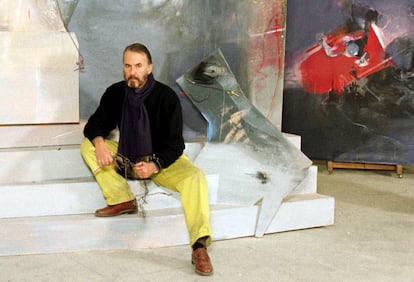The Spanish painter Javier de Villota, who in his artistic career of more than four decades stood out for his treatment of human rights, has died in Madrid at the age of 82, family sources have informed EFE. Grandnephew of the Spanish painter and writer José Gutiérrez Solana (1886-1945), his pictorial training was self-taught and he began painting at the age of 13, although in reality he trained as an architect at the Higher Technical School of Architecture in Madrid, where he also worked. as head of Shape Analysis.
In 1972 he was awarded in the painting category at the National Exhibition of Fine Arts and the State acquired the work, which today is in the permanent collection of the Museo Nacional Centro de Arte Reina Sofía. In that same decade he held his first individual exhibitions in Spain and abroad where he was related to the New Figuration movement. Starting in 1978, he decided to abandon teaching to dedicate himself fully to sculpture and painting, investigating the dialogue between abstraction and figuration, and since the 1980s he has lived between Spain and the United States.
Among the series that it has developed in the last 40 years, it is worth highlighting Biafra, The Grays, Inquisition, The Spain of ’98, Lebanon, Kingston Hospital, Death Market, ETA, Lesvos o Echoes in dehumanization. Of special relevance was the exhibition in Madrid, in 2013, of the retrospective Echoes in dehumanization, after his time at the Station Museum in Houston (USA), which summarized the “definitive phase” of his career after traveling throughout America to imbue his “European painter approach” with the Latin American patina.
The Inquisition, war crimes, genocides, ethnic cleansing supported by fundamentalism, sexist violence or the experience of pain and illness are the themes on which Villota poured his creativity, and on which, as defined at that time, Retrospectively, “the painting spills like blood, generating an atmosphere of restlessness, sometimes bathed in diaphanous light.” Human rights is the great issue that has haunted him since 1994 when he installed 40 life-size polyester figures in the streets of Madrid that represented the corpses of a massacre of civilians that occurred a year earlier during the Balkan War.
In the last decade of his career, the inclusion of his work in the group exhibition stands out internationally. Turning Points, in 2014, organized by at the Hungarian Museum of Fine Arts in Budapest, as well as his solo exhibitions in Mexico Lines of NO Freedomheld at the Tlatelolco University Cultural Center, UNAM in Mexico City. Abstraction and Urgency, exhibited at the Manuel Felguerez Museum of Abstract Art in Zacatecas, it could also be seen in an adaptation at the Museum of the Americas in Washington in 2018, which was the last public appearance of his work.
Since 2015, Javier de Villota was a corresponding academic at the Royal Academy of Fine Arts of San Telmo in Málaga and a car enthusiast, like his brother Emilio, one of the first Spaniards to compete in Formula One in Spain. Javier was the uncle of the ill-fated driver of the premier motorsport category María de Villota. His work has become part of the permanent collections of entities such as the National Museum of Fine Arts in Santiago, the National Museum of Art in La Paz and the Center for Contemporary Art in Quito.

